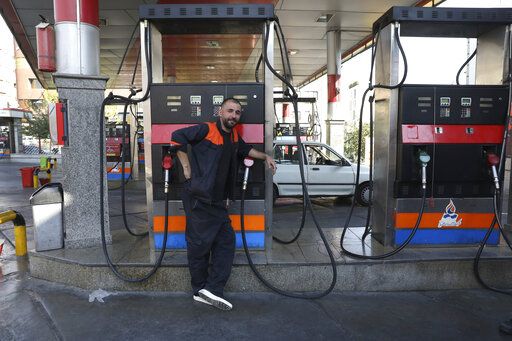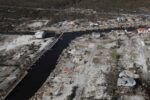Iran says cyberattack affected every gas station in nation
A worker leans against a gasoline pump that has been turned off, at a gas station in Tehran, Iran, Tuesday, Oct. 26, 2021. Gas stations across Iran on Tuesday suffered through a widespread outage of a system that allows consumers to buy fuel with a government-issued card, stopping sales. One semiofficial news agency referred to the incident as a cyberattack. (AP Photo/Vahid Salemi)
DUBAI, United Arab Emirates (AP) — A cyberattack in Iran affected all of the Islamic Republic’s 4,300 gas stations, a senior official said, as some still faced problems Wednesday.
No group has claimed responsibility for the attack that began Tuesday, though it bore similarities to another months earlier that seemed to directly challenge Iran’s Supreme Leader Ayatollah Ali Khamenei as the country’s economy buckles under American sanctions.
Abolhassan Firouzabadi, the secretary of the Supreme Council of Cyberspace, linked the attack to another that targeted Iran’s rail system in July, in comments reported by the state-run IRNA news agency.
“There is a possibility that the attack, like a previous one on railway system, has been conducted from abroad,” Firouzabadi said.
He added that an investigation into the incident was underway.
On Wednesday morning, IRNA quoted another official who claimed 80% of Iran’s gas stations had begun selling fuel again.
Tuesday’s attack rendered useless the government-issued electronic cards that many Iranians use to buy subsidized fuel at the pump. The semiofficial ISNA news agency, which first called the incident a cyberattack, said it saw those trying to buy fuel with a government-issued card through the machines instead receiving a message reading “cyberattack 64411.”
While ISNA didn’t acknowledge the number’s significance, that number is associated with a hotline run through Khamenei’s office that handles questions about Islamic law. ISNA later removed its reports, claiming that it too had been hacked. Such claims of hacking can come quickly when Iranian outlets publish news that angers the theocracy.
Farsi-language satellite channels abroad published videos apparently shot by drivers in Isfahan, a major Iranian city, showing electronic billboards there reading: “Khamenei! Where is our gas?” Another said: “Free gas in Jamaran gas station,” a reference to the home of the late Supreme Leader Ayatollah Ruhollah Khomeini.
The use of the number “64411” mirrored the attack in July targeting Iran’s railroad system that also saw the number displayed. Israeli cybersecurity firm Check Point later attributed the train attack to a group of hackers that called themselves Indra, after the Hindu god of war.
Indra previously targeted firms in Syria, where President Bashar Assad has held onto power through Iran’s intervention in his country’s grinding war.
Cheap gasoline is practically considered a birthright in Iran, home to the world’s fourth-largest crude oil reserves despite decades of economic woes.
Subsidies allow Iranian motorists to buy regular gasoline at 15,000 rials per liter. That’s 5 cents a liter, or about 20 cents a gallon. After a monthly 60-liter quota, it costs 30,000 rials a liter. That’s 10 cents a liter or 41 cents a gallon. Regular gasoline costs 89 cents a liter or $3.38 a gallon on average in the U.S., according to AAA.
In 2019, Iran faced days of mass protests across some 100 cities and towns over rising gasoline prices. Security forces arrested thousands and Amnesty International said it believes 304 people were killed in a government crackdown. Tuesday’s cyberattack came in the same month in the Persian calendar as the gasoline protests in 2019.
The attack also came on the birthday of the late Shah Mohammad Reza Pahlavi who, stricken with cancer, fled the country in 1979 just before the Islamic Revolution.
Iran has faced a series of cyberattacks, including one that leaked video of abuses at its notorious Evin prison in August.
The country disconnected much of its government infrastructure from the internet after the Stuxnet computer virus — widely believed to be a joint U.S.-Israeli creation — disrupted thousands of Iranian centrifuges in the country’s nuclear sites in the late 2000s.
Copyright 2021 The Associated Press. All rights reserved.


